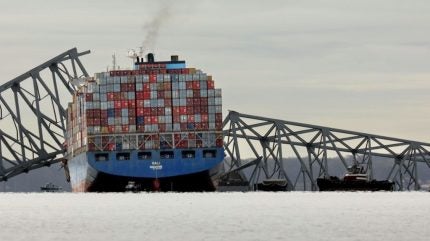
New details have emerged in the first court filing around the Baltimore bridge accident, as the owner and manager of the Dali filed a petition under the Shipowners Limitation of Liability Act to ask for “exoneration” from liability over the disaster.
Grace Ocean Private Limited is the Singapore-registered owner of the ship, and fellow Singaporean company Synergy Marine is the “manager” of the container ship and is therefore responsible for staffing and communication between Grace Ocean and the ship’s time charterers. “At all relevant times, Synergy had substantial control of and exercised dominion over the Vessel,” according to the filing.
The filing at the US District Court in Maryland gives details of the moments leading up to the Dali’s collision with the Francis Scott Key Bridge and of the value of the ship, its cargo, and estimates of the cost of damage and repairs.
The petition asked the Court to recognise the crash did not occur due to negligence or a fault of the owners and managers of the ship.
“13. The Casualty was not due to any fault, neglect, or want of care on the part of Petitioners, the Vessel, or any persons or entities for whose acts Petitioners may be responsible.
14. Alternatively, if any such faults caused or contributed to the Casualty, or to any loss or damage arising out of the Casualty, which is denied, such faults were occasioned and occurred without Petitioners’ privity or knowledge.”
The term “Casualty” is used in its legal sense and refers to the Bridge itself as the damaged party.
Owner’s account
The filing contains confirmation of the weight and load carried by the Dali at the time, along with the companies’ account of the incident.
It confirmed the ship was carrying 4,679 containers en route from Baltimore to Yantian, China, via Sri Lanka. It confirmed that pilots had left the vessel, and a “loss of power” was the immediate cause of the deadly accident.
“8. At or about 00:40 local time on March 26, 2024, the Vessel left berth at the Port of Baltimore with two tugs alongside and a pilot onboard, as is the requisite procedure in the Port of Baltimore. At or about 00:55 local time, the aft tug cast off from the Vessel. At or about 00:57 local time, the Vessel turned to port. At or about 01:08 local time, the forward tug cast off from the Vessel.
9. The Vessel entered the shipping channel at or about 01:08 local time and was heading 141 degrees true. Approximately seven to ten (7-10) minutes later, the Vessel experienced a loss of power and propulsion in the shipping channel. The Vessel made efforts to regain power, which occurred briefly, but power was lost a second time shortly thereafter. The Vessel drifted to starboard, then dropped anchor in response to the loss of power and propulsion.
10. At or about 01:28 local time on March 26, 2024, the Vessel allided with the Key Bridge (the “Casualty”).
11. As a result of the Casualty, portions of the Key Bridge collapsed and were damaged. The Vessel and certain cargo aboard also sustained damage.”
New channels
The Court filing was made in the same period that two temporary shipping lanes were opened in Baltimore, in an effort to reopen the busy port.
The first has a draught of only 11ft (3.35 metres) but the second is hoped to have further clearance of approximately 16ft (4.8 metres) to allow larger ships to access the harbours.
There is still a 1,800-metre exclusion zone around the site of the former bridge, which is being worked on by two crane barges which are attempting to remove the bridge debris from the waterway.
Tugboats and low-draught barges are currently the only vessels allowed to traverse the temporary lanes.



